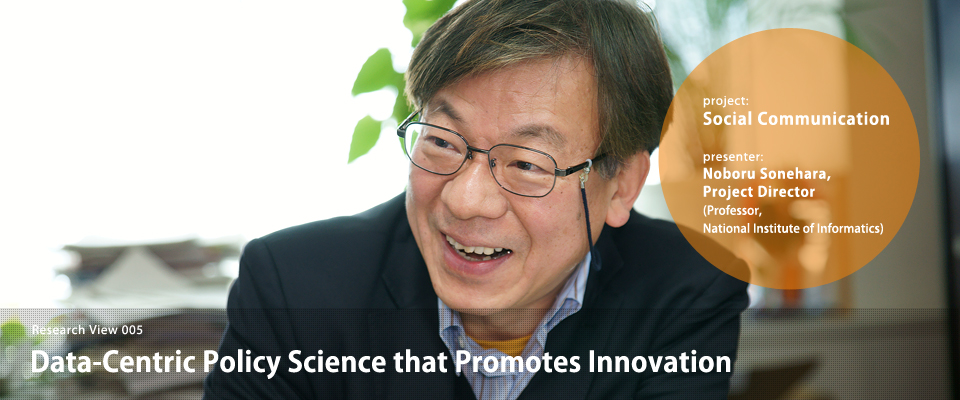In the data-centric science research commons, Professor Noboru Sonehara is the leader of two projects-“Human and Social Data” and “Social Communication (Communication Informatics)”-and is advancing integrated research. Based on the areas of real- and cyber-spaces related to humans and society, he is pursuing research to use technology that profitably utilizes information in the age of Big Data in the fields of education, medicine and health, disaster prevention, tourism, and agriculture, which will serve as the driving force behind regional regeneration and innovation.

From experience and intuition to data-centric decision making
From the standpoint of policy decisions and decision making, it has been fairly difficult to make rational judgments on human society until recently. In other words, There has been nothing but to make subjective judgments based on experience and intuition using partial data and incomplete knowledge. However, Japanese society has rapidly put in place a network environment and a sensing environment, and today we are able to collect big data through computers, smartphones, and other devices. Thus, I think that determining prices and making various policy decisions based on scientific data will cause tremendous economic regeneration and innovation.

Why do so many suicides occur on sloping land?
Every year in Japan, about 30,000 people commit suicide. Many of these suicides are among the elderly people, and commuter trains are often stopped because of people jumping onto railway tracks. Can science do something about this? The subtheme that takes up this problem involves a multifaceted approach of utilizing and investigating a range of public statistical data and issuing alerts when there are hints and suggestions on social networking services(SNS) such as Twitter, that someone may commit suicide. For instance, we understand from this data that the suicide rate is very high among people who live on the lands that slopes are 15 degrees or more. Why is this so? It may be because people tend to become stuck in their homes and are left alone with their problems. It is important to identify such physical conditions that cause social issues so that they do not have “psychological” problems. If we apply this knowledge, we can see that it might give us some important suggestions on moving residences occupied by the elderly to high ground as a tsunami countermeasure.

An IT hub for “tourism” as the engine of regional regeneration
Tourism policy is another area in which IT is expected to have economic effects. There are about 1,720 local governments across Japan, and each local government provides tourism guidance and manually compiles and investigates statistics. In addition, under the current situation tourist sites may not be the target of local-government investigation and policy if they are located outside the boundary of the local government’s city, town, or village—even if that distance is only 100 meters. Therefore, according to the “Web Data-Driven Tourism Forecast System” developed by Project Researcher Yu Ichifuji (Transdisciplinary Research Integration Center), by horizontally collecting, accumulating, and analyzing the enormous volume of data on various websites related to diverse lodgings, it is possible to go beyond the framework of administrative districts to forecast lodging conditions and room rates in tourist regions. Moreover, on March 11, 2013, historical data was confirmed in terms of the form it took, and the reliability of the data was verified through survey research conducted in cooperation with Kyoto City Tourism MICE Promotion Office. As the tourism forecast system can also be used in other regions-even Yamanashi prefecture, where an increase in overseas tourists is expected following the registration of Mt Fuji as a World Heritage site-this system is starting to be applied to guesthouses and other small-scale lodgings. Further, a system is being developed that applies this data to real-estate information to support decision making related to subdivisions, letting, and renovations. What do properties have a risk of remaining unsold? Where should capitals be invested for renovations? It will become possible to answer these sorts of questions from judgments based entirely on data.

Developing a disaster prevention and mitigation support tool from a participation-type application
It is well known that for emergency systems, it is more useful to use an existing system that also operates during times of non-emergency than a specially developed system solely for emergency. Therefore, the “Web Data-Driven Tourism Forecast System” can be actually used during emergencies in the same way as during non-emergency periods. For example, it can be used in relation to measures to return evacuees to their homes when a disaster has occurred. In addition, from the “Nationwide Student Contest to Develop a Smartphone App” held in 2013 through industry-academia collaboration, the “Tendenko Rally”(Tohoku Institute of Technology) app was created to instruct children who, for instance, are on their way home from school, with respect to where they should evacuate to in relation to their current location. Local children joined university students and travelled around town recording evacuation sites. The university students then integrated this data and created a hazard map as a tool for use when a disaster occurs. This tool is expected to be widely used in many regions in the future.

(Text in Japanese: Noboru Sonehara, Rue Ikeya. Photographs: Mitsuru Mizutani. Published: April 1, 2014)





